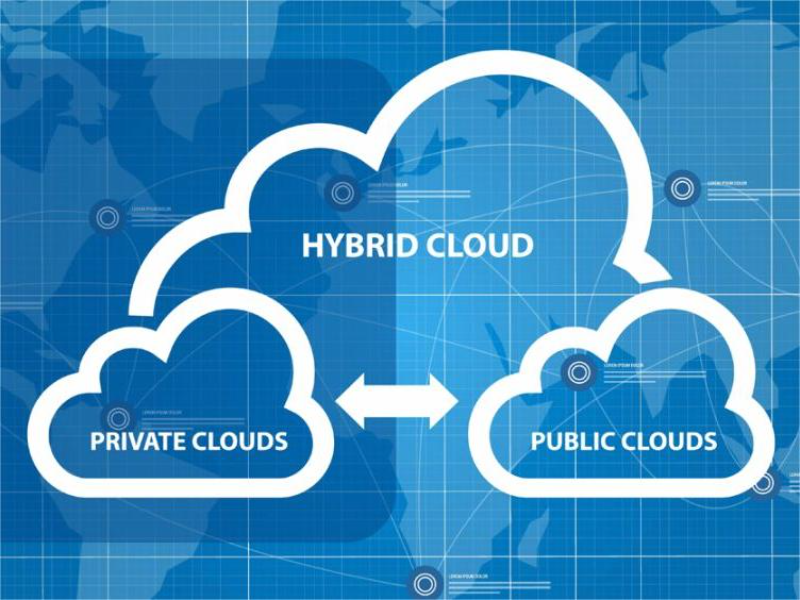- Hybrid cloud architecture refers to an environment that combines on-premises, private cloud, public cloud, and edge Settings to create a single, flexible managed IT infrastructure.
- As an architectural model, hybrid cloud plays a key role in digital transformation, providing enterprises with a flexible, portable, and cost-effective way to do so.
- With the popularity of commercial cloud computing and the increasing need for digital transformation, enterprises are turning to hybrid cloud solutions to control costs and improve overall agility.
How does hybrid cloud architecture work?
Hybrid cloud architecture refers to an environment that combines on-premises, private cloud, public cloud, and edge Settings to create a single, flexible managed IT infrastructure.
As an architectural model, hybrid cloud plays a key role in digital transformation, providing enterprises with a flexible, portable, and cost-effective way to modernise existing legacy applications, deploy data, and run workloads across multiple computing environments.
Hybrid cloud architectures are complex and vary based on individual business needs and use cases. While there is no one-size-fits-all approach to building a hybrid cloud infrastructure, they all share hybrid computing environments (both on-premises and off-site), including:
Local Environment (“Local”): A traditional form of computing that involves an organisation running and managing computing resources, networks, storage, and software on hardware and servers in its own physical location, such as in an office building or local data centre.
Private cloud environment: A cloud computing environment in which all resources are isolated and run exclusively for one organisation. Private clouds combine many of the benefits of cloud computing with the security and control of on-premises IT infrastructure.
Public cloud environment: A type of Cloud computing hosted by a third-party Cloud service provider (CSP), such as Amazon Web Services (AWS), Microsoft Azure, IBM Cloud, or Google Cloud. These public cloud service providers host public cloud IT resources, such as individual virtual machines (VMS) and other cloud computing services, on the public Internet on a pay-per-use basis.
Many mid-sized businesses use more than one, and most large businesses use all three of the cloud provider services listed below:
Infrastructure-as-a-service (IaaS) provides computing, networking, and storage resources to consumers on demand, over the Internet, and pay-as-you-go. IaaS enables end users to scale up and down resources as needed, reducing the need for high up-front capital expenditures or unnecessary “own” infrastructure, especially when workloads proliferate.
Platform as a Service (PaaS) provides a complete cloud platform (such as hardware, software, and infrastructure) for developing, running, and managing applications without the cost, complexity, and inflexibilities associated with building and maintaining that platform on-premises.
Software as a Service (SaaS) refers to application software hosted in the cloud for end-user applications (e.g. Zoom, Dropbox). SaaS service providers are responsible for operating, managing and maintaining the software and the infrastructure on which it runs. SaaS is the most common public cloud service and the dominant software delivery model.

Building blocks of a hybrid cloud architecture
The ideal hybrid cloud architecture provides enterprises with high-performance computing and storage capacity, low-latency network connectivity, virtualisation, and robust security.
In addition to combining applications running on multiple resources (on-premises, private cloud, and public cloud infrastructure), hybrid cloud architectures include these other key components.
1. Network connection
Network connectivity is a key component of a hybrid cloud architecture. Network connections enable sharing of resources across multiple locations.
Hybrid cloud connectivity relies on the use of the following technologies:
A VPN (virtual Private Network) establishes a secure point-to-point connection between two network endpoints (nodes). A VPN establishes an encrypted channel that keeps the data transmitted by the user, as well as identity and access credentials, private over the Internet. With VPNS, on-premises and private cloud infrastructures can be securely connected over a private, secure connection over a public network.
WAN (Wide Area Network) connects computers over a wide area, such as from one area to another, or even from one continent to another. The Internet is the largest wide area network, connecting billions of computers around the world. In the enterprise business, the WAN connects offices, data centres, cloud applications, and cloud storage. Cloud-based wide area networks allow organisations to connect local networks in corporate offices and data centres with cloud-based storage, applications and other resources.
An API (Application Programming Interface) is a set of defined rules that enable different applications to communicate with each other, acting as an intermediate layer for processing data transfers between systems. Apis allow companies to open up their application data and functionality to external third-party developers, business partners, and internal departments. In a hybrid cloud architecture setup, apis are invoked through HTTP requests between clouds to connect applications, databases, and networks.
2. Virtualisation
Modern hybrid cloud architectures rely on virtualisation technology, which uses software to create an abstract layer of a virtual computing system on physical hardware, essentially creating multiple virtual computers called virtual machines (VMS). Virtualisation was originally developed for enterprises by VMware and is a key component of enterprise cloud computing. It enables organisations to run multiple virtual computers, operating systems, and applications on a single physical server. It also allows users to purchase computing resources as needed and scale those resources cost-effectively as workloads grow.
In addition to virtual servers, hybrid cloud architectures use many other types of virtualisation, including network virtualisation. Network virtualisation includes software-defined networking (SDN), which virtualises the hardware (called the “control plane”) that controls the routing of network traffic. Network Function Virtualisation (NFV) virtualises one or more hardware devices that provide a specific network function, such as a firewall, load balancer, or traffic analyser, making these devices easier to configure, configure, and manage.
Virtualisation also enables infrastructure-as-a-Code (IaC), which automates infrastructure configuration, enabling developers to develop, deploy, and scale cloud applications faster, at lower risk, and at lower cost.
3. Containerisation
Containers are lightweight, executable application components that combine application source code with all operating system (OS) libraries and dependencies needed to run the code in any environment, and are an essential part of modern hybrid cloud architectures. Instead of virtualising the underlying hardware such as VMS, containers virtualise the operating system (usually Linux or Windows).
With greater portability and resource efficiency than virtual machines (VMS), containers have become the de facto unit of computing for modern cloud-native applications. Cloud-native applications are built specifically to run in the cloud, designed by DevOps and other teams to be scalable, and made up of microservices, also known as microservice architectures. This means that a single application consists of many smaller, loosely coupled, and independently deployable components or services.
Microservices speed up the development and deployment of software because each service can be developed and deployed individually. Many leading businesses have moved from developing monolithic applications to microservice applications, such as Amazon, which uses microservices to track user activity, their history, and other data to provide real-time recommendations for a better customer experience.
4. Unified hybrid cloud management
Today’s hybrid cloud approach involves a unified platform for discovering, manipulating, and managing on-premises, private, and public cloud data and resources. The combination of hybrid cloud platforms and tools unifies compute, storage, networking, database, analytics, and security functions to provide consistency and reliability across a diverse hybrid cloud environment.
Also read: Hitachi and Cisco launch new hybrid cloud hosting services
Common Hybrid Cloud platforms with pre-configured hardware, software, and services include AWS Outposts, Google Cloud Platform, VMware Hybrid Cloud, and Red Hat OpenShift. Each platform typically integrates standard cloud technologies such as Kubernetes to orchestrate container-based services and other software-based functions. These unified management tools are used to monitor, allocate, and manage these resources from a single management platform, providing an IT and network management strategy for consolidating multiple monitoring tools and data feeds into a single interface.
Here’s a rundown of the key features associated with a hybrid cloud management platform:
Resource Management
Hybrid cloud hosted services tools help stakeholders allocate and reallocate resources on premises and in cloud environments based on application requirements. For example, organisations like financial institutions can use private clouds to hold sensitive customer information and public clouds to test new applications, such as mobile banking applications.
Workload orchestration
Hybrid cloud architectures use container orchestration tools, such as Kubernetes or Docker Swarm, to automate containerised workloads. These technologies help developers quickly deploy, run, and synchronise containers across clusters of servers in different locations. They also enhance the scalability of containerised workloads, which means DevOps and other teams can automatically add Kubernetes clusters running containerised applications as needed, reducing downtime and optimising performance.
Data integration
Hybrid environments collect and process data from a variety of different sources, which requires data integration, the process of combining data from multiple source systems to create a unified view.
Data management solutions for hybrid cloud include data analytics software platforms that use artificial intelligence (AI) and machine learning to collect, organise, and analyse data. Many of these data integration tools employ the design concept of data structures that run on top of various technologies in a mixed environment, combining data from multiple source systems to create a unified view.
Data Governance
Data governance tools provide another layer of technology in a hybrid cloud architecture for organisations to create and maintain policies and protocols that outline how their data must be stored, managed, and used according to compliance and regulatory standards.
Security
Hybrid cloud security involves the technologies and best practices used to protect an organisation’s sensitive information in an environment where data and applications flow across a combination of on-premises, private and public cloud platforms. The security layer of a hybrid cloud architecture involves technical controls such as encryption, network authentication, and management software:
Data encryption
Data encryption is used in hybrid cloud Settings to protect sensitive data from data breaches or cyberattacks, including malware and ransomware.
Identity and Access Management (IAM) : The IAM Management tool is a standard authorisation method that creates digital identities for all users to proactively monitor and restrict them during all data interactions.
Security Information and Event Management (SIEM) : The SIEM management tool provides a security monitoring and observability console, as well as a comprehensive security orchestration solution that automates threat monitoring, real-time threat detection, and response.
Disaster Recovery (DR) : Hybrid cloud-based disaster recovery tools provide data protection for data backup, retention, and retrieval to speed the recovery of lost data and restore normal business operations.
Benefits of hybrid cloud architecture
A hybrid cloud architecture offers several advantages, including:
Agility and scalability
Hybrid cloud architectures increase agility by quickly assigning and unassigning resources in on-premises, public or private clouds to easily respond to changing business needs. Thanks to on-demand cloud resources, hybrid clouds also offer virtually unlimited scaling up or down.
Business continuity
Hybrid cloud deployments reduce downtime by optimising business continuity by replicating mission-critical data to the cloud and enabling scalability during periods of peak demand.
Cost savings
A hybrid cloud strategy can help reduce capital expenditures by moving workloads to the public cloud, avoiding the ongoing costs associated with maintaining and upgrading legacy hardware.
Application modernisation
A hybrid cloud environment provides the flexibility and security to modernise applications, which is to update legacy applications to a scalable cloud-native application environment. This allows applications to be built quickly, deployed automatically, and updated regularly, avoiding waterfall development cycles.
Adopt Generative AI
Hybrid cloud infrastructure accelerates generative AI and its heavy reliance on large amounts of data and large language models (LLMS) by providing unlimited storage capabilities, computing power, and fast scalability.

